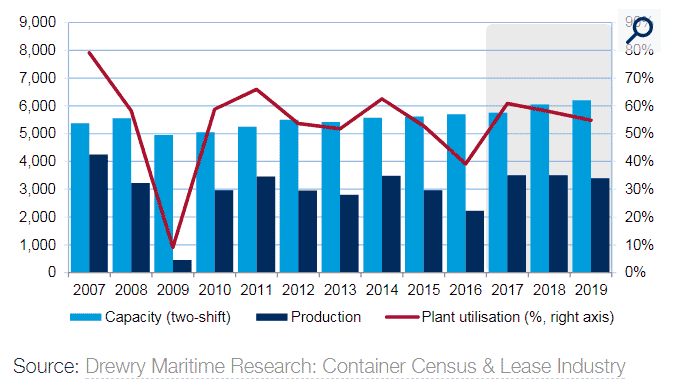Some observers of global logistics are predicting that shippers and carriers might soon find that the market for ocean shipping containers will become very tight as we move into 2018?
Why? As usual in such scenarios, there are a variety of factors. First, continued growth in demand, and global trade and container volumes are once again back on a growth path, driven by generally strong economic conditions in much of the world.
Supply Chain Digest Says... |
|
|
Add to that new regulations that will take effect in China in April that require manufacturers there to start using water-based paints instead of the traditional solvent-based coatings. The water-based paints take longer to dry, especially in cooler months, extending manufacturing and delivery times.
Many Chinese manufacturing plants also shut down in February for maintenance, followed by the more general closing around the Chinese New Year.
Given that China currently produces about 95% of the world's shipping containers, all this could add up to real tightness in the market.
But the analysts are Drewry say there is enough slack in total Chinese production capacity that in total it should be able to respond to demand – even if there are some spot shortages in the first half of 2018.
Drewry predicts, for example, that container manufacturers will produce about 3.5 million TEU for all of 2017. But it says most plants have been running with one or 1.5 shifts per day, meaning utilization therefore of generally around 60-70%.
But Drewry notes that If those factories moved to double-shift production, capacity would be close to 5.5 million TEU per year, or 50% more than current production volumes – although Drewry in fact is predicting total production will also be about 3.5 million TEU in 2018.
See the graphic below.
Container Manufacturing Capacity, Production and Plant Utilization ('000 TEU)

But, Drewry says, there is a safety valve that might also release some pressure. Today, most demand for containers come from leasing companies, as the carriers themselves have moved towards exited the business of owning containers.
(See More Below)
|
CATEGORY SPONSOR: SOFTEON |
|
|
| |
|
|
"Most new purchases in recent years have been for replacement rather than expansion," Drewry writes, adding that "That makes sense, since the leasing companies own a large number of older units bought from transport operators in recent years. If there is a tightening of supply, the leasing firms have much more scope to hang on to their older units rather than scrap them, thus artificially expanding supply. Those boxes will eventually have to go, but we are looking at a short-term tightening of supply rather than a long-term crisis."
And container manufacturing companies are benefiting from the increased demand and modest shortage of container.
For example, Hong Kong's Singamas Holdings, the world's second largest container manufacturer, recently said that it expects a $100 million turnaround in its financial fortunes in 2017. The company released guidance in mid-December that it expected to report a profit of not less than $40 million for the year, compared with a loss of $59.4 million in 2016.
Meanwhile, the price of containers is also heading higher. In 2016, with the overall slump in container shipping, prices plunged to below $1,500 for a standard 20 foot container from around $1,800 the year before.
Now, however, prices have risen to more than $2000 per TEU, according to industry sources speaking to the The Loadstar web site.
In the end, Drewry says, "There is some slack in the system. Current production capacity is under-utilized, so factories not affected by climatic problems could increase their production for a short time if demand does spike. Even with the new paint rules, this hardly looks like a major crisis, so lessors and shippers alike can relax."
Do uou think a container shortage is looming? Let us know your thoughts at the Feedback section below.
Your Comments/Feedback
|